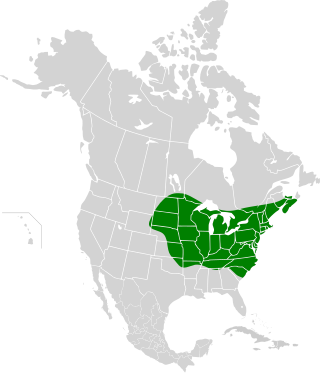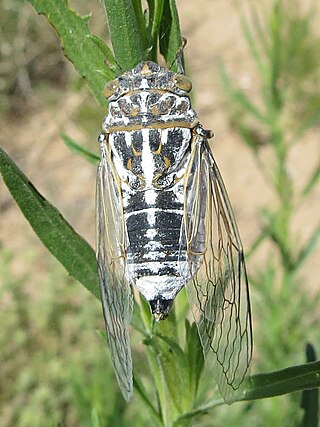
The cicadas are a superfamily, the Cicadoidea, of insects in the order Hemiptera. They are in the suborder Auchenorrhyncha, along with smaller jumping bugs such as leafhoppers and froghoppers. The superfamily is divided into two families, the Tettigarctidae, with two species in Australia, and the Cicadidae, with more than 3,000 species described from around the world; many species remain undescribed. Nearly all of cicada species are annual cicadas with the exception of the few North American periodical cicada species, genus Magicicada, which in a given region emerge en masse every 13 or 17 years.

Cicadas of the genus Neotibicen are large-bodied insects of the family Cicadidae that appear in summer or early fall in eastern North America and formerly Bermuda. Common names include cicada, harvestfly, jar fly, and the misnomer locust.

The family Mycteridae is a small group of tenebrionoid beetles with no vernacular common name, though recent authors have coined the name palm and flower beetles. The family Mycteridae is distributed worldwide. There are about 30 genera and 160 species in three subfamilies Mycterinae, Hemipeplinae and Lacconotinae (=Eurypinae). These 3 subfamilies are extremely diverse in appearance and are sometimes difficult to have a present diagnosis of the adults at the family level. About 20 species are found in Australia, species of three genera are found in North America The larvae are generally flattened and typically inhabit the spaces between leaves or the bases of fronds, where they appear to consume fungi.

Neotibicen canicularis is a species of annual cicada.

Annual cicadas are Cicadidae species that appear every summer. The life cycle of a so-called annual cicada typically spans 2 to 5 years; they are "annual" only in the sense that members of the species reappear annually. The name is used to distinguish them from periodical cicada species, which occur only in Eastern North America, are developmentally synchronized, and appear in great swarms every 13 or 17 years. All other cicadas from all other biogeographic regions produce annual broods, so the distinction is not made outside of North America.

Chelonariidae or turtle beetles is a family of beetles in the superfamily Byrrhoidea. It was described by Blanchard in 1845. There are 3 genera with around 300 described species. Little is known of their ecology, though it seems they are associated with the roots of orchids and the nests of ants and termites. Their exoskeletons are heavily sclerotised and their limbs can be effectively retracted into their bodies due to the presence of socket-like cavities. Adult specimens have seed-shaped bodies that are typically colored brown or black with lighter patches.

The genus Hadoa comprises large-bodied Cicadidae occurring in Western North America. Until recently, these species were in the genus Tibicen, which has now been redefined so as to include only a few European species, while most species from the Eastern and Central US are now placed in Neotibicen and Megatibicen.
Neotibicen bermudianus, also colloquially known as the Bermuda cicada, is an extinct species of annual cicada that was endemic to the island of Bermuda.

Neotibicen robinsonianus, commonly called Robinson's cicada, is a species of large-bodied annual cicada in the genus Neotibicen. It is native to the Eastern United States.
Neotibicen latifasciatus, commonly called coastal scissor grinder cicada, is a species of annual cicada in the genus Neotibicen.
Megatibicen figuratus, commonly called the fall southeastern dusk-singing cicada, is a species of annual cicada in the genus Megatibicen. Prior to its reclassification to the genus Megatibicen, M. figuratus was included in the genus Neotibicen.
Neotibicen auriferus, commonly called field cicada, is a species of annual cicada in the genus Neotibicen.

Megatibicen resonans, commonly called resonant cicada or southern pine barrens cicada, is a species of annual cicada in the genus Megatibicen. Prior to its reclassification to the genus Megatibicen, M. resonans was included in the genus Neotibicen.

Megatibicen is a genus of cicadas in the family Cicadidae, with about 10 described species. Until 2016, these species were included in the genus Tibicen and then briefly in Neotibicen. The species formerly of genera Ameritibicen Lee, 2016 and Gigatibicen Lee, 2016 are now considered species of Megatibicen Sanborn & Heath, 2016.

Neotibicen davisi, known generally as the Davis' southeastern dog-day cicada or southern dog-day cicada, is a species of cicada in the family Cicadidae.

Neotibicen lyricen, the lyric cicada, is a species of cicada in the family Cicadidae.

Neotibicen pruinosus, commonly known as the scissor grinder, is a species of cicada in the family Cicadidae.

Neotibicen winnemanna, commonly called the Eastern scissor(s) grinder, is a species of large bodied annual cicada in the genus Neotibicen. It is native to the Eastern United States, particularly the Piedmont Plateau and the outlying lower mountainous elevations of the Appalachians and inner, western portion of the Atlantic coastal plain.
Neotibicen similaris is a species of annual cicada in the genus Neotibicen. It is native to the Southeastern United States. Initially, N. similaris encompassed one distinct species of Neotibicen, though Marshall and Hill described in 2017 an apparent subspecies of N. similaris native to the Apalachicola region of Florida, Georgia, and Alabama. The initial species described now consists the N. similaris subspecies N. similaris similaris, while the newly described variant occupies the N. similaris apalachicola subspecies. They are similar, and the most reliable means of distinguishing the subspecies is the distinctive call of N. similaris apalachicola males; however, despite the distinctness of the mating calls, the two subspecies appear to hybridize in areas in which they overlap, resulting in songs that combine elements of both.














